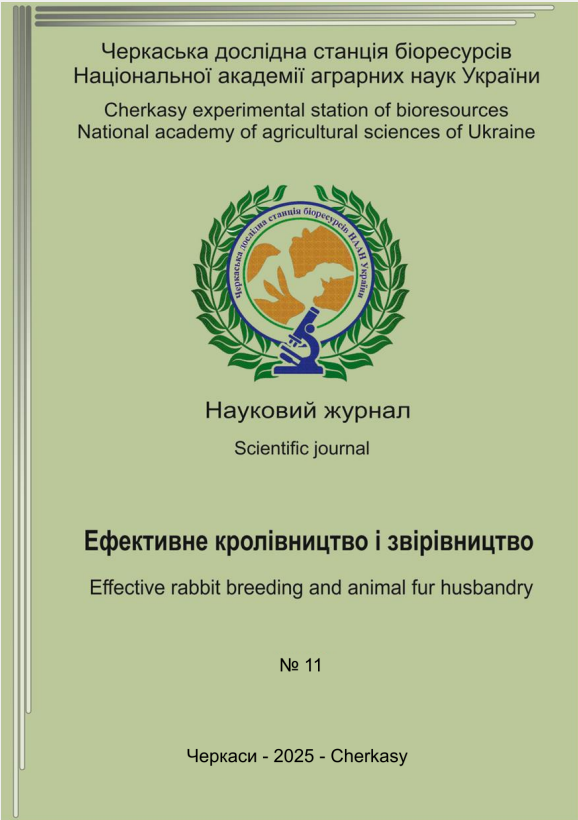Analysis of the growth and productivity of rabbits obtained from males of different breeds used in a crossbreeding scheme
DOI:
https://doi.org/10.37617/2708-0617.2025.11.185-196Keywords:
rabbits, cross, Poltava silver breed, male sires, weight gain, industrial technologyAbstract
The development of rabbit breeding is extremely relevant today, as rabbits are characterized by high growth rates, short generation intervals and high fertility, and rabbit meat is a valuable dietary product with a high content of easily digestible protein.
Sire males occupy an important place in the structure of the herd and are the basis of the gene pool of a modern rabbit meat production enterprise. Given the high cost of importing males, there is an urgent question of the effectiveness of using purebred males of the local gene pool as a parental form to obtain young animals for fattening. In this regard, a study was conducted on the productivity of rabbits obtained from males of different breeds to study the effectiveness of their use in the crossbreeding scheme.
As a result of the research, it was found that the highest live weight in newborns was in rabbits obtained from PS59 males. They were 2.4 g higher (p ≤ 0.01) than newborn rabbits obtained from Hyla Max males. The live weight of newborn rabbits from Hyla Max and Thermon White males was approximately the same - 58.6 and 58.1 g, respectively. Newborn rabbits from Poltava Silver males had the lowest live weight. At the time of weaning, the highest live weight was characterized by rabbits obtained from PS59 males, but the difference in this trait compared to young animals from Hyla Max and Thermon white males was insignificant - 11.5 and 21.5 g.
At the time of completion of fattening (70 days), the highest live weight was in rabbits obtained from PS59 males - 2581.9 g. In young animals that came from Hyla Max males, it was 65.6 g less (p ≤ 0.05), and in rabbits obtained from Thermon White males - 94.2 g. The lowest value of live weight at the age of 70 days was characterized by rabbits obtained from males of the Poltava Silver breed - it was 250.0 g less (p ≤ 0.001) than in their peers from Hyla Max males.
Thus, the results of the conducted studies indicate that the highest live weight at the time of slaughter was characterized by rabbits that came from males of the parental form of the HyPlus cross, while the lowest was in young animals that came from purebred males of the Poltava Silver breed. The data obtained indicate the need for further breeding work with the population of Poltava Silver rabbits in the direction of increasing their live weight and growth rate.
References
Potential and limitations of rabbit meat in maintaining food security in Ukraine / G. Zamaratskaia et al. Meat science. (2023). 109 – 293 p. URL: https://doi.org/10.1016/j.meatsci.
Growth performance of male line of superior tropical rabbit / B. Brahmantiyo et al. Tropical Animal Science Journal. (2021). Vol. 44, no. 3. 273 – 279 p. URL: https://doi.org/10.5398/tasj.2021.44.3.273 .
Гончар, О. Ф., Бойко, О. В., Гавриш, О. М. (2020). Аналіз стану галузі кролівництва в Україні. Effective rabbit breeding and fur farming. № 6. 47 – 58 с. URL: https://doi.org/10.37617/2708-0617.
Fontanesi, L. (2016). The rabbit in the genomics era: applications and perspectives in rabbit biology and breeding. In: Proceedings of the 11th World Rabbit Congress. 15-18 p.
Якубець, Т., Бочков, В. (2024). Економічна ефективність використання самців у схрещуванні ліній кролів. Effective rabbit breeding and fur farming. № 10. 131 – 143 c. URL: https://doi.org/10.37617/2708-0617.
Genetic evaluation of growth traits in new synthetic rabbit line in egypt / E.-S. Abdel-Kafy et al. Open journal of agricultural research. (2021). Vol. 1, no. 2. 62 – 73 p. URL: https://doi.org/10.31586/ojar.119 .
Economic weights in rabbit meat production / L. Cartuche et al. World rabbit science. (2014). Vol. 22, no. 3. 165 p. URL: https://doi.org/10.4995/wrs.2014.1747 .
Akanni, K. T. (2024). Sire’s strain influence on livability and growth traits in a diallel crossed rabbits. Nigerian journal of animal production. 142 – 146 p. URL: https://doi.org/10.51791/njap.vi.4284 .
Efficiency of crossing paternal line males and maternal line females of rabbits on growth performance / G. Abd El-latif et al. Egyptian poultry science journal. (2021). Vol. 41, no. 4. 709 – 722 p. URL: https://doi.org/10.21608/epsj.2021.213293.
Norton, T., Cambra-López, M. (2025). Challenges and opportunities for precision livestock farming applications in the rabbit production sector. World rabbit science. Vol. 33, no. 2. 127 – 138 p. URL: https://doi.org/10.4995/wrs.2025.22701 .
Crossbreeding parameters for body weight data from a complete diallel mating scheme using three breeds of rabbit / A. M. Abdel-Ghany et al. Archives animal breeding. (2024). Vol. 67, no. 3. 335 – 342 p. URL: https://doi.org/10.5194/aab-67-335-2024.
Shevchenko, E., Honchar, O. (2024). Usage of different blup methods in index evaluation of poltavske sriblo rabbit breed. Effective rabbit breeding and fur farming. No. 10. 22 – 30 p. URL: https://doi.org/10.37617/2708-0617.2024.10.22-30 .
Genetic characteristics of Poltavske sriblo rabbits by myostatin and progesterone receptor gene and selection indices / Y. Shevchenko et al. Studia Biologica. (2023). Vol. 17, no. 2. 71 – 84 p. URL: https://doi.org/10.30970/sbi.1702.714
Гончар, О., Шевченко, Є. (2018). Застосування методів геномної селекції при дослідженні кролів новозеландської білої породи. Ефективне кролівництво і звірівництво. № 4. 46 – 54 c.
Гавриш, О. М. (2020). Ефективність використання індексної оцінки в системі добору та використанні племінного поголів’я кролів породи полтавське срібло. Effective rabbit breeding and fur farming. № 6. 38 – 47 c. URL: https://doi.org/10.37617/2708-0617.2020.6.38-47 .
Reproductive traits of chinchilla rabbits under different three-breed crossbreeding schemes / I. S. Luchyn et al. Scientific and technical bulletin оf state scientific research control institute of veterinary medical products and fodder additives аnd institute of animal biology. (2025). Vol. 26, no. 1. 118 – 126 p. URL: https://doi.org/10.36359/scivp.2025-26-1.14 .
Ібатуллін, І. та ін. (2017). Методологія та організація наукових досліджень у тваринництві /. Київ : Аграрна наука. 328 с.


